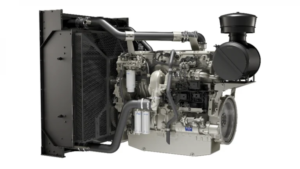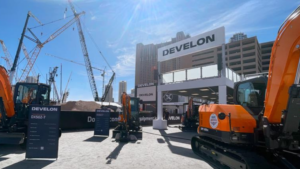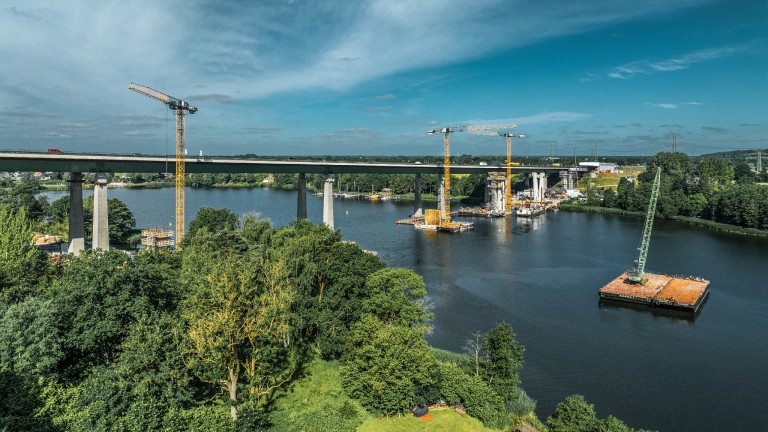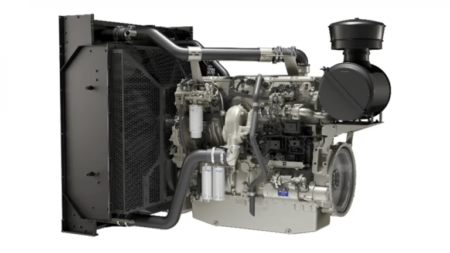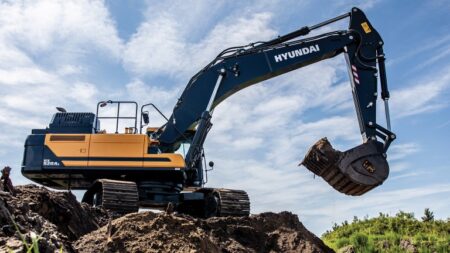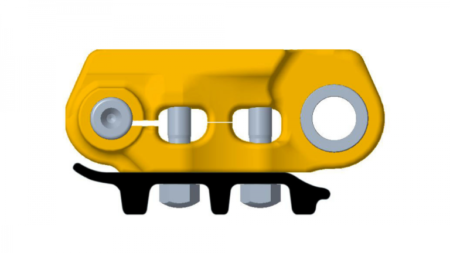The first crane used for the replacement of the Rader High Bridge was assembled on the new pile cap of the first bridge pier.
Liebherr
Strategic planning proves successful
Precise planning was required in advance for the use of the cranes, and Liebherr’s project department for large and special projects provided support. A major challenge lay in the cranes being assembled by the crawler crane on the floating platform. As the permissible hook height of the crawler crane on the floating platform was restricted, the assembly height had to be kept as low as possible. However, a certain tower height was also necessary so that the cranes could be climbed. Various options and tower systems were investigated in the run-up to the project to find the best solution.
The configuration of the tower combinations was another major issue before planning crane operations; it was essential to prevent the towers from colliding with the newly erected bridge piers and any potential tower deformations. Consequently, the fast-erecting cranes are only partly utilizing their maximum hook height. The two 65 K cranes are in use with their tower retracted as they slew under the bridge, and the three 81 K cranes are also assigned to work under the bridge and at maximum height above it. Of the 13 flat-top cranes are assembled in a free-standing position on crosses and foundation anchors, some are set in concrete in the water. They are working with a hook height of between 49 and 68 metres.
Weather conditions present an extra challenge during construction work. The Rader High Bridge is closed to empty lorries and cars with trailers from wind force nine onwards (storms with wind speeds of 75 to 88 km/h). If the wind picks up further, it can be closed to all vehicles over 7.5 tonnes. In the event of a hurricane (wind force 12), the bridge is closed completely. The wind conditions therefore had to be taken into account in the cranes’ static calculations.
Built in two stages
The Rader High Bridge is located east of the town of Rensburg, approximately 30 kilometres from Kiel and around 65 kilometres from Flensburg. Traffic currently flows across the Kiel Canal, Rader Island, and Borgstedter Enge (part of Borgstedt Lake) on four lanes and two hard shoulders. The bridge’s piers stand both on land and in the water. Three piers are being erected in the water and require a foundation of 40-metre-deep bored piles.
The new build is happening in two stages with traffic flowing along the existing bridge and the Kiel Canal. The eastern half of the bridge is being built first, next to the existing bridge, and is expected to be opened to traffic in 2026. Following this, the original bridge will close and be demolished, with the western bridge section being built in its place. The new structure is being widened to six lanes and should be finished in 2031.
The bridge piers for the eastern replacement structure are being erected first. Steel parts for the substructure arrive as four-metre-long components and are welded together on land to create elements up to 80 metres in length. These are then pushed along toward the next pier using the incremental launching method, with one increment being one bridge segment. To do this, the piers have to be erected in advance of the launching process. Work has started north of the bridge and is progressing southwards towards Lake Borgstedt and across Rader Island in the direction of the Kiel Canal. There is also work underway to the south of the bridge on the banks of the canal.
Segment reaches the first pier
The first bridge segment reached the first pier in June 2024. This particular segment is 56 metres long, 14 metres wide, and six metres high. Hydraulic presses moved the segment, which weighs several tonnes, at a speed of nine to ten metres per hour southwards towards the first pier. The replacement structure will consist of a total of 14 sections, with one advancement planned for every six to seven weeks.
Read the full article here


